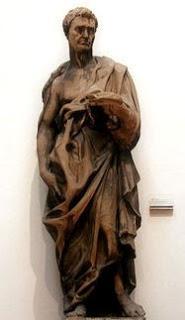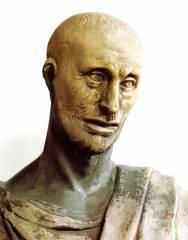
Prophet Jeremiah, Donatello
During the XV century Italy was able to admire the development of a great artist, Donatello. The history of art is full with eminent names of the artists and their masterpieces –shining testimonies of the past. I wanted to focus on two sculptures of Donatello that I had the opportunity to admire in the Museo dell'Opera del Duomo in Florence. I will give you the link of this museum because, if you were in Florence, I suggest you make a visit. http://museo.operaduomo.fi.it/The statues are the Prophet Jeremiah and the Prophet Habakkuk. Both date back to 1425. The first measures m 1,91 x0, 45, the second m 1,95 x0, 54. Both were originally positioned in a recess of the bell tower, now in the same place there are the copies. Why I wanna talk about these two statues? Simply because these statues were in controversy with the classical art. The Greek sculptures linked the concept of beauty with the goodness and consequently the ugliness is linked with badness, to create a uniform iconography representative. Donatello was sick of these rules and he broke the classic iconography. His prophets can be the normal men of the people. Why Donatello did this? Because he was deeply convinced that the man has the reason and this dominates himself and the world.
This quality is not related to his physical appearance, not necessarily those who are beautiful are overachiever. The prophets of Donatello are not men inspired by God, but men who speak because they had a painful life and they realized the truth across the sorrow.

prophet habakkuk. the face
The drama of this idea is given by the strong contrasts of the light and the shadow created with a clever alternation of bare body parts with the soft draping. If you stop to admire their faces you will grasp the expression and not the beauty. Faced with these two works that I define as intense art works, the question is: how can a human hand be able to extract from a marble slab these emotions? I can not answer but I admire them in silence.Nel 1400 l’Italia poté ammirare lo sviluppo di un grande artista Donatello. Di grandi nomi illustri la storia dell’arte è piena le loro opere sono testimonianza di un fulgido passato. Volevo soffermarmi su due opere scultoree di questo artista che ebbi modo di ammirare al Museo dell’opera del duomo di Firenze. Vi riporto il link del museo perché qualora foste a Firenze vi suggerisco di fare una visita. Le statue sono Il profeta Geremia e Il profeta Abacuc. Entrambe risalgono al 1425. La prima misura m 1,91x0,45, la seconda m 1,95x0,54. Entrambe erano originariamente posizionate in una nicchia del campanile , oggi nella stessa nicchia sono state messe delle copie. Perché proprio queste due statue? Semplicemente perché Donatello entrò in polemica con l’arte classica. La scultura greca univa il concetto di bello al buono e conseguentemente il cattivo al brutto per creare una logica uniforme nell’iconografia rappresentativa. Donatello si stufa di queste regole e spezza l’iconografia classica. I suoi profeti sono persone qualunque del popolo. Perché Donatello fa questo? Perché è profondamente convinto che l’uomo ha la ragione e con questa domina se stesso e il mondo: questa qualità non è legata al suo aspetto fisico, non necessariamente deve essere bello chi è di potere . I profeti di Donatello non sono uomini ispirati da Dio ma uomini che parlano perché hanno una vita sofferta e con questa hanno capito la verità. La drammaticità di questa idea è data dal forte contrasto di luci ed ombre create con un sapiente alternarsi di parti del corpo nude con morbidi drappeggi. Se vi fermate ad ammirare i loro visi coglierete non la bellezza ma l’espressività. Di fronte a queste due opere che mi pace definire intense, la domanda è una: come può una mano essere in grado di estrarre da una lastra di marmo queste emozioni? Non posso che ammirare in silenzio.

